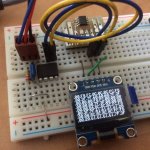retepsnikrep
Senior Member
Displaying hex numbers? I'm being thick I think 
I'm using the code from the manual for "readowsn" to get the serial numbers for a DS18b20 sensor, but I don't want to use debug to display it, I want to output the hex numbers to my serial display using serout.
Can that be done? I did try a search and find it's easy to display the ascii value but I want the hex result displayed.
The point is the end user will note down these hex numbers and then use them in the 'multiple temp sensor on one input' reading code to address specific sensors.
http://www.picaxeforum.co.uk/showthread.php?t=8171&highlight=DS18b20
Thanks Peter
I'm using the code from the manual for "readowsn" to get the serial numbers for a DS18b20 sensor, but I don't want to use debug to display it, I want to output the hex numbers to my serial display using serout.
Can that be done? I did try a search and find it's easy to display the ascii value but I want the hex result displayed.
The point is the end user will note down these hex numbers and then use them in the 'multiple temp sensor on one input' reading code to address specific sensors.
http://www.picaxeforum.co.uk/showthread.php?t=8171&highlight=DS18b20
Thanks Peter

